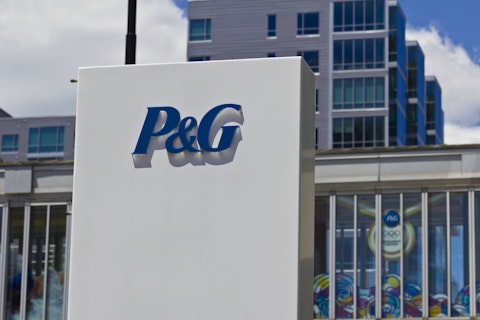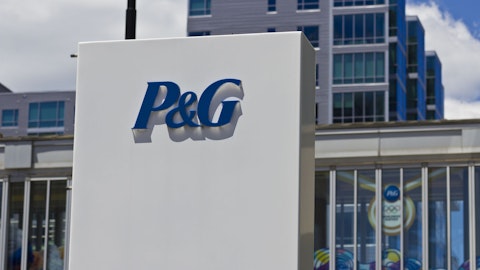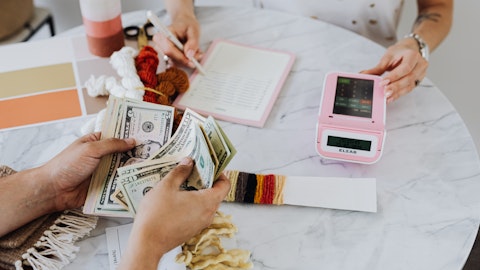The Procter & Gamble Company (NYSE:PG) Q2 2023 Earnings Call Transcript January 19, 2023
Operator: Good morning, and welcome to Procter & Gamble’s Quarter End Conference Call. Today’s event is being recorded for replay. This discussion will include a number of forward-looking statements. If you will refer to P&G’s most recent 10-K, 10-Q and 8-K reports, you will see a discussion of factors that could cause the company’s actual results to differ materially from these projections. As required by Regulation G, Procter & Gamble needs to make you aware that during the discussion, the company will make a number of references to non-GAAP and other financial measures. Procter & Gamble believes these measures provide investors with useful perspective on underlying business trends and has posted on its Investor Relations website, www.pginvestor.com, a full reconciliation of non-GAAP financial measures. Now I will turn the call over to P&G’s Chief Financial Officer, Andre Schulten.
Andre Schulten: Good morning. Joining me on the call today are Jon Moeller, Chairman of the Board, President and Chief Executive Officer; and John Chevalier, Senior Vice President, Investor Relations. We’re going to keep our prepared remarks brief and then turn straight to your questions. Execution of our integrated strategies continued to yield good results in the October to December quarter, growing organic sales in nine of 10 categories, holding global aggregate market share, continued productivity savings, improving supply efficiency, sustained investment and superiority of our brands across all five vectors: product, package, communication, go-to-market and value continue to pay benefits for our consumers and retail partners and in turn, for P&G shareholders.
Progress against our plan fiscal year-to-date enables us to increase the guidance range for organic sales growth and maintain ranges for core EPS growth, free cash flow productivity and cash return to shareowners. Moving to the second quarter numbers. Organic sales grew 5%, pricing at a 10 points to sales growth and mix was up 1 point. Volume declined 6 points driven by a combination of market contraction, trade inventory reductions and portfolio reduction in Russia. Growth was broad-based across business units with each of our 10 product categories growing or holding organic sales. Personal Health Care grew high teens, Feminine Care, Fabric Care and Home Care were up high single digits. Hair Care was up mid-single digits. Baby Care, Family Care, Oral Care and Skin and Personal Care were each up low single digits.
Grooming was in line with prior year. Focus markets grew 3% for the quarter, with the U.S. up 6%. Greater China organic sales were down 7% versus prior year, as the market continued to be impacted by COVID lockdowns and weaker consumer confidence. We continue to expect a slow recovery as consumer mobility increases over the coming quarters. Long term, we expect China to return to strong underlying growth rates. Enterprise markets were up 14% with each of the three regions up 10% or more. Global aggregate market share was in line with prior year with 27 of our top 50 category country combinations holding or growing share. In the U.S., all outlet value share was in line with prior year with seven of 10 categories holding or growing share. U.S. volume share is up 0.5 point versus the prior year quarter, delivering sequential improvement from quarter one.
Recent innovations like Downy Rinse and Refresh in fabric enhancers and Dawn Powerwash in hand dishwashing are extending superiority advantages and driving value and volume share growth. Innovation also serves as a catalyst for pricing across our other brands and forms in their category segments. On the bottom line, core earnings per share were $1.59, down 4% versus prior year. On a currency-neutral basis, core EPS increased 5%. Core operating margin decreased 170 basis points, primarily due to gross margin pressure from commodities and foreign exchange. Currency-neutral core operating margin decreased 70 basis points. Productivity improvements were 110 basis points help to the quarter. Adjusted free cash flow productivity was 72%, primarily due to a temporary reduction in payables.
We returned $4.2 billion of cash to shareowners, approximately $2.2 billion in dividends and $2 billion in share repurchase. In summary, considering the backdrop of a very challenging cost and operating environment, continued solid results across the top line, bottom line and cash for the first half of the fiscal year. Moving on to strategy. Our team continues to operate with excellence, executing the integrated strategies that have enabled strong results over the past four years, and that are the foundation for balanced growth and value creation. A portfolio of daily use products, many providing cleaning, health and hygiene benefits in categories where performance plays a significant role in brand choice. Ongoing commitment to and investment in irresistible superiority across the five vectors of product, package, brand communication, retail execution and value.

Copyright: jetcityimage / 123RF Stock Photo
As discussed during our Investor Day in November, we are renewing our superiority standards to reflect the dynamic nature of this strategy. Productivity improvement in all areas of our operations to fund investments in superiority offset cost and currency challenges, expand margins and deliver strong cash generation. An approach of constructive disruption, a willingness to change, adapt and create new trends and technologies that will shape our industry for the future, especially important in this volatile environment. Finally, an organization that is increasingly more empowered, agile and accountable with little overlap or redundancy, flowing to new demands, seamlessly reporting each other to deliver against our priorities around the world.
Going forward, there are four areas we are driving to improve the execution of the integrated strategies, Supply Chain 3.0, digital acumen, environmental sustainability and employee value creation. These are not new or separate strategies. They are necessary elements in continuing to build the priority, reduce cost to enable investment and value creation and to further strengthen our organization. We expanded on each of these at our Investor Day in November. If you weren’t able to attend or listen in remotely, I encourage you to review the materials on our IR events website. Our strategic choices on portfolio, superiority, productivity, constructive disruption and organization are interdependent strategies. They reinforce and build on each other.
When executed well, they grow markets, which in turn grow share, sales and profit. We continue to believe that the best path forward to deliver sustainable top and bottom line growth is to double down on these integrated strategies starting with commitment to deliver irresistible superior propositions to consumers and retail partners. Now moving to guidance. We continue to expect more volatility in costs currencies and consumer dynamics as we move through the second half of the fiscal year. However, we think the strategies we’ve chosen, the investments we’ve made and the focus on executional excellence have positioned us well to manage through this volatility over time. Raw and pack material costs inclusive of commodities and supplier inflation are still a significant headwind versus last fiscal year, though we have seen some modest sequential improvement.
Based on current spot prices and latest contracts, we now estimate a $2.3 billion after-tax headwind in fiscal ’23. Foreign exchange is also a significant year-on-year headwind. But like raw and pack materials, we’ve seen modest directional improvement. Based on current exchange rates, we now forecast a $1.2 billion after-tax impact for the fiscal year. Freight costs remain higher versus prior year, and we continue to expect the $200 million after-tax headwind in fiscal ’23. Combined headwinds from these items are now estimated at approximately $3.7 billion after tax, $1.50 per share, a 26 percentage point headwind to EPS growth for the year. For perspective, recall that we began the year expecting approximately $1.33 of cost and FX headwinds.
So despite some modest relief since last quarter, our current outlook is still $0.17 worse than our ingoing position. We are offsetting a portion of these cost headwinds with price increases and productivity savings. We are continuing to invest in irresistible superiority, and we are investing to improve our supply capacity, resilience and flexibility. As we’ve said before, we believe this is a bottom line rough patch to grow through with continued investment in the business and underlying strategies. As I noted at the outset, our solid first half results enable us to raise our organic sales outlook and confirm our guidance ranges on EPS and cash. We are increasing our guidance for organic sales growth from a range of 3% to 5% to a range of 4% to 5%.
Within this company-wide range, we — there are many puts and takes. As I mentioned, we expect to see some modest improvement in China, but European markets have softened as high inflation affects consumer spending. The U.S. remains relatively strong to date, and most enterprise markets remain resilient. On the bottom line, we’re maintaining our outlook of core earnings per share growth in the range of in line to plus 4% versus prior year. The significant headwinds from input costs and foreign exchange keep our current expectations towards the lower end of this range. This guidance also reflects our intent to remain fully invested to drive our superiority strategy and increase investments as opportunities are available. We continue to forecast adjusted free cash flow productivity of 90%.
We expect to pay around $9 billion of dividends and to repurchase $6 billion to $8 billion of common stock, combined a plan to return $15 billion to $17 billion of cash to shareowners this fiscal year. This outlook is based on current market growth rate estimates, commodity prices and foreign exchange rates. Significant additional currency weakness, commodity cost increases, geopolitical disruptions, major production stoppages or store closures are not anticipated within these guidance ranges. To conclude, we continue to face high year-over-year commodity and transportation cost inflation in the upstream supply chain and in our own operations, headwinds from foreign exchange, geopolitical issues, COVID disruptions impacting consumer confidence and historically high inflation impacting consumer budgets.
These macroeconomic and market level consumer challenges we’re facing are not unique to P&G, and we won’t be immune to the impact. We attempt to be realistic about these impacts in our guidance and transparent in our commentary. As we’ve said before, we believe this is a rough patch to grow through, not a reason to reduce investment in the long-term health of the business. We’re doubling down on the strategy that has been working well and is delivering strong results. We continue to step forward towards our opportunities, and we remain fully invested in our business. We are committed to driving productivity, improvements to fund growth investments, mitigate input cost challenges and to deliver balanced top and bottom line growth. With that, we’re happy to take your questions.
See also Top AI Healthcare Stocks to Buy and 10 Penny Stocks that will Make You A Millionaire.
Q&A Session
Follow Procter & Gamble Co (NYSE:PG)
Follow Procter & Gamble Co (NYSE:PG)
Operator: Your first question comes from Dara Mohsenian of Morgan Stanley.
Dara Mohsenian : So just a couple of questions on the full year guidance. Obviously, you didn’t change the earnings guidance despite FX and commodities each being a little less negative than you originally thought. Is that more sort of making up for some of the sequential moves that we saw in Q1? Is it more you assuming reinvestment in the back half? Or is there something else in the back half? Just help us understand the reasoning there. And basically, the same question on top line. I don’t want to get into a 10-part question, but there’s a bunch of sort of back and forth here. You raised the low end of the full year org sales range, but Q2 decelerated a bit versus Q1, the back half in theory implies a deceleration and volumes were a little weaker in the quarter. So maybe just taking a step back, how do you feel about the business in terms of looking at retail takeaway in fiscal Q2 and thoughts on the back half of the year?
Andre Schulten : All right. I’ll give it a try, Dara. So on the total year forecast, I think we have one results in, we are on track, very well on track to deliver the year and the guidance ranges that we’re communicating. When you look at our EPS delivery for the balance of the year, we are assuming, as we always do, current spot rates on commodities and foreign exchange. And given our desire to reinvest, we would not assume that every dollar that we see in commodities and foreign exchange immediately flows through to the bottom line. We see significant upside for us to continue to invest in superiority across all five vectors. And if that upside is available to us, we will do that in the short term and the midterm. We have — also, as we said in the prepared remarks, we are still above ingoing assumptions.
So $0.17 worse than we had at the time when we provided the initial guidance. So that leads us to continue to be pointed towards the lower end of the core EPS range. But as you say, with more help coming, that probably is increasing our confidence to deliver that range or hopefully slightly better. On the top line, again, when we look at the half one results, we feel very good about our standing here to deliver a higher — the higher end of our initial top line guidance. So that’s why we raised to 4% to 5% organic sales growth. And the fact that we see low volumes in the current quarter really is important to understand in more depth. So the 6% or 5.8% negative volume on the quarter, when you dissected about half of that is not really consumption-driven.
So we have 1 point related to our portfolio choice in Russia, where we cut the portfolio by 50% to focus on essentials versus the full portfolio we were operating before. We have about 2 points related to temporary inventory reductions, which we saw in China with the market heavily impacted by COVID lockdowns and O&D. And especially on the offline side of the market, we see retailer inventories reduced reserve cash. We saw some inventory reduction in power Oral Care and Appliances in Europe. And we have seen in late December, very strong consumption in the U.S., where retail orders haven’t quite kept up with that consumption. So if you strip that out, the actual consumption-related volume decline is about 3% on the quarter, which is in line with what we’ve seen in quarter one, which is in line with our expectation and elasticities that we would have expected, given the amount of pricing that is in the market.
What is encouraging to us to raise the top line guidance is that our volume shares are holding globally, our value shares are holding globally. And when we look at the U.S., our biggest and most important markets, we actually see an acceleration of volume share by 50 basis points over the past three months and even 80 basis points over the past one month. Again, all of that gives us confidence to raise the top line guidance while we want to preserve the flexibility to continue to invest in the priority to drive more sustainable growth. And honestly, that’s going to be our job here over the next few quarters, continue to drive household penetration to reinvigorate overall volume growth in the category.
Jon Moeller : Dara, this is Jon. I would just add a couple of pieces of perspective at a macro level. The world seems to want everything to be better as do I. That’s really not reality though. There’s an incredible amount of uncertainty that remains. None of us, I think, globally really understand what the recovery rate in China is going to be as an example. And nobody really understands what the new policies and practices are going to mean in terms of consumer confidence in that context. You have the war in Eastern Europe. You have the highest inflation rates in 40 years. You have continued volatility in both the currency markets and the commodity markets. And importantly, that currency exposure for us is not a simple dollar exposure.
There’s a lot of cross rate exposures within that, which I realize makes it difficult to penetrate. But for example, the cross rate between the British pound and the euro has a significant impact on our bottom line. So all that put together, while I’m extremely happy with the progress the organization is making I’m extremely confident that the strategy that we have is the right one that’s going to continue to serve us well. It’s just not an easy time to be taking up guidance to the top range of possibility.
Operator: The next question comes from Lauren Lieberman of Barclays.
Lauren Lieberman : You covered a lot in that answer. So I’m going to switch gears a little bit and maybe talk about capacity investments. I think one of the big drag to gross margin this quarter was this capacity investments. I know there have been some particular areas like Fem Care, Oral is a big focus. So if you could talk a little bit maybe about anything — Fem Care, beyond Fem Care where you’re putting incremental capacity in to what degree you expect that to remain a drag to profitability over the next couple of quarters? Or is it a multiple year dynamic? Because that would also speak to some pretty healthy expectations around longer-term volume trends. And I think that’s particularly relevant also as we look a little bit beyond the next quarter or two.
Andre Schulten : Yes, Lauren. We are — the short-term effect that we are describing here is indeed Fem Care related. We see on the top end of the portfolio, very strong growth. We have seen very strong growth over the past two years. And we are just need to catch up in terms of overall capacity to demand ratio, both on the top end of our pads business, which is the Radiant or Infinity business. And as you well know, we’re still not up to full demand levels on tampons, which we will install — are in the process of installing new capacity in the back half. The investments across businesses to catch up to the very significant increase in terms of business size is underway. So we have capacity investments across most businesses.
I wouldn’t expect it to be a significant drag on the bottom line. In fact, the growth that we anticipate will more than outweigh the cost of investing in capacity, and that’s the plan, obviously. So we have high confidence in our growth potential and that’s really what’s triggering these capacity investments. Just in the U.S., for example, the last quarter was the first quarter we’ve reached $40 billion in sales, up from $30 billion in sales just four years ago. So — and again, our growth rate continues to look very positive. Volume shares are up and better than the market, our volumes are trending to positive numbers year-over-year. So we need to keep up with that. The net of it is all positive.





